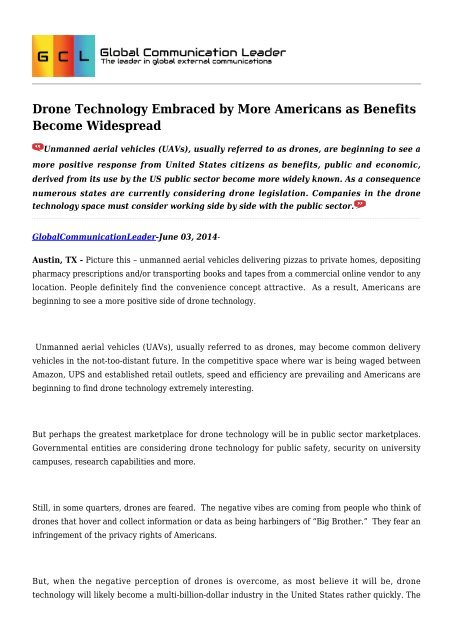Drone Technology Embraced by More Americans as Benefits Become Widespread
Create successful ePaper yourself
Turn your PDF publications into a flip-book with our unique Google optimized e-Paper software.
<strong>Drone</strong> <strong>Technology</strong> <strong>Embraced</strong> <strong>by</strong> <strong>More</strong> <strong>Americans</strong> <strong>as</strong> <strong>Benefits</strong><br />
<strong>Become</strong> <strong>Widespread</strong><br />
Unmanned aerial vehicles (UAVs), usually referred to <strong>as</strong> drones, are beginning to see a<br />
more positive response from United States citizens <strong>as</strong> benefits, public and economic,<br />
derived from its use <strong>by</strong> the US public sector become more widely known. As a consequence<br />
numerous states are currently considering drone legislation. Companies in the drone<br />
technology space must consider working side <strong>by</strong> side with the public sector.<br />
GlobalCommunicationLeader-June 03, 2014-<br />
Austin, TX - Picture this – unmanned aerial vehicles delivering pizz<strong>as</strong> to private homes, depositing<br />
pharmacy prescriptions and/or transporting books and tapes from a commercial online vendor to any<br />
location. People definitely find the convenience concept attractive. As a result, <strong>Americans</strong> are<br />
beginning to see a more positive side of drone technology.<br />
Unmanned aerial vehicles (UAVs), usually referred to <strong>as</strong> drones, may become common delivery<br />
vehicles in the not-too-distant future. In the competitive space where war is being waged between<br />
Amazon, UPS and established retail outlets, speed and efficiency are prevailing and <strong>Americans</strong> are<br />
beginning to find drone technology extremely interesting.<br />
But perhaps the greatest marketplace for drone technology will be in public sector marketplaces.<br />
Governmental entities are considering drone technology for public safety, security on university<br />
campuses, research capabilities and more.<br />
Still, in some quarters, drones are feared. The negative vibes are coming from people who think of<br />
drones that hover and collect information or data <strong>as</strong> being harbingers of “Big Brother.” They fear an<br />
infringement of the privacy rights of <strong>Americans</strong>.<br />
But, when the negative perception of drones is overcome, <strong>as</strong> most believe it will be, drone<br />
technology will likely become a multi-billion-dollar industry in the United States rather quickly. The
Federal Aviation Administration (FAA) to date h<strong>as</strong> issued fewer than 400 permits for drones, but that<br />
number is expected to incre<strong>as</strong>e exponentially in the coming years.<br />
Here’s a strong indication of acceptance – numerous states are currently considering drone<br />
legislation. They simply are not waiting for the federal government to move.<br />
Tex<strong>as</strong> is in the forefront of the trend toward commercialization of drone technology. Tex<strong>as</strong><br />
A&M-Corpus Christi w<strong>as</strong> selected <strong>by</strong> the FAA to be one of the sites in only six states chosen for<br />
testing of drones. A&M-Corpus Christi h<strong>as</strong> been involved in drone research for a couple of years at<br />
its Lone Star Unmanned Aircraft Systems Center.<br />
According to the Association of Unmanned Vehicles International, once American airspace is opened<br />
to the use of UAVs, the economic impact statewide is expected to be huge. Consider that in Tex<strong>as</strong><br />
there could be an $8 billion impact, including a $260 million impact in South Tex<strong>as</strong> over the next<br />
decade. <strong>More</strong> than 1,200 new jobs would also be created.<br />
Not all UAVs being used <strong>by</strong> the federal government carry weapons or belong to the military. Many<br />
drones are used for public safety or to manage a crisis situation. Some have been used for dis<strong>as</strong>ter<br />
surveillance and dis<strong>as</strong>ter relief.<br />
America h<strong>as</strong> more than 60 drone sites. And, counted in that number are half a dozen in Tex<strong>as</strong>. The<br />
city of Arlington uses unmanned aircraft, or drones, for police operations. The Arlington Police<br />
Department’s drone is a battery-powered, remote-controlled helicopter less than 50 feet long and it<br />
is “armed” with camer<strong>as</strong>.<br />
In Oklahoma City, fire officials are studying the use of drones to battle wild fires, providing real-time<br />
video of the fire area and changing wind directions. That information can help firefighters survey an<br />
area, collect data and know that they will not be trapped <strong>by</strong> a changing wind pattern. <strong>Drone</strong>s have<br />
been instrumental in saving lives of firefighters.<br />
Researchers in Michigan are testing drone technology for mapping roads, identifying potholes and<br />
studying traffic patterns. A project of a division of the U.S. Department of Transportation called
Unpaved Roads is working to help states monitor unpaved roads and predict when critical repairs<br />
are needed.<br />
Aviation technology students at Purdue University are being taught how to operate and fly drones<br />
indoors. Purdue officials believe that training individuals is a huge marketplace of the future. The<br />
FAA plans to issue guidelines for drone operation for commercial purposes in 2015.<br />
Off the W<strong>as</strong>hington co<strong>as</strong>t, environmental researchers are using drones to monitor marine wildlife.<br />
The uses of drone technology are extremely diverse.<br />
Forest Service officials have used drones to spot fires and battle wildfires. Parks service employees<br />
can also use drones to find lost hikers. Public officials <strong>as</strong> well <strong>as</strong> environmentalists see drones <strong>as</strong> a<br />
vehicle that allows them to survey are<strong>as</strong> after natural dis<strong>as</strong>ters such <strong>as</strong> floods or tornadoes.<br />
With adequate, but not suppressive regulation, the use of drones <strong>by</strong> the government sector will be<br />
successful. The trick will be to balance the technology with privacy issues. This can definitely be<br />
done <strong>as</strong> drone technology is too large an economic driver to be stifled <strong>by</strong> misinformation and<br />
unwarranted fear. Companies in the drone technology space must consider working side <strong>by</strong> side<br />
with the public sector to ensure that education and success stories reach citizens to remove fear and<br />
promote public support.<br />
<strong>Technology</strong> and infr<strong>as</strong>tructure leaders in this emerging new drone market interested in reaching<br />
American officials and obtaining additional examples of current projects can find more information<br />
at http://www.spartnerships.com<br />
About the Company<br />
Strategic Partnerships, Inc. (SPI) is a full-service government affairs and procurement consulting<br />
firm. SPI teams work with clients to identify upcoming opportunities and capture new business. SPI<br />
is recognized <strong>as</strong> a pioneer in the business of partnering public and private entities for commercial<br />
purposes. For more information contact Anna Scott, Corporate/External Relations, at 512-531-3919<br />
and/or visit http://www.spartnerships.com
When the negative perception of drones is overcome, <strong>as</strong> most believe it will be, drone<br />
technology will likely become a multi-billion-dollar industry in the United States rather<br />
quickly<br />
Press Rele<strong>as</strong>e Link:<br />
[1] http://pressrele<strong>as</strong>eleader.com/pressrele<strong>as</strong>e/29806.html


















